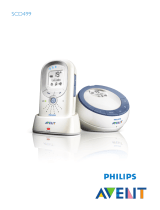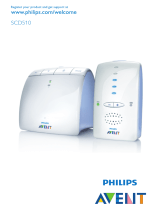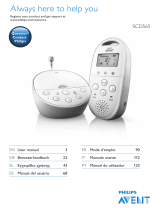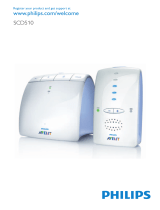Page is loading ...

3
A. Baby unit
B. Parent unit

EN
4
A. Baby unit
A-1 On/Off button (y)
A-2 LINK light
A-3 Night light
A-4 Volume – / + buttons
A-5 Microphone
A-6 PAGE button
A-7 Night light button ( )
A-8 Battery check light ( )
A-9 Battery compartment cover
A-10 DC 9V / 300mA power supply jack
A-11 AC power adapter
B. Parent unit
B-1 TALK button
B-2 SENSITIVITY button
B-3 DC3.6V / 200mA power supply jack
B-4 Loudspeaker
B-5 Microphone
B-6 On/Off button (y)
B-7 Battery check light ( )
B-8 LINK light
B-9 Sound-level lights
B-10 Volume – / + buttons
B-11 Recess for the belt clip
B-12 Battery compartment cover
B-13 Belt clip
B-14 AC power adapter
C.What else you need
Both units can be mains or battery operated.
For battery-operated use you will need:
– 4 x 1.5V, AA batteries for baby unit (not supplied)
– 2 x 1.5V, AAA batteries for parent unit (not supplied)
Legend of functions

EN
3 Illustrations
4 Legend of functions
4 Baby unit
4 Parent unit
4 What else you need
5 Contents
6 Welcome
6 Safety information
6 Getting your baby monitor ready for use
6 Baby unit
7 Parent unit
8 Using your baby monitor
9 Other features
9 Adjusting loudspeaker volume
10 Talking to your baby
10 Adjusting microphone sensitivity
11 Monitoring baby silently
11 Switching night light on / off
12 Connecting / disconnecting belt clip
12 Paging parent unit
13 Troubleshooting
15 Frequently asked questions
16 Important information
16 Technical specifications
16 Maintenance
17 Environmental information
17 Factory initialization mode
18 Guarantee and service
Contents
5

Philips is dedicated to producing caring, reliable products to give parents the reassurance they
need.You can trust this Philips baby monitor to provide round-the-clock support by ensuring you
can always hear your baby clearly without any distracting noise.
Your SCD487 uses DECT technology which guarantees zero interference from other wireless
appliances and a clear signal between the parent unit and baby unit.
Philips Baby Care, taking care together
Safety information
Please read this user manual carefully before using your baby monitor and keep it for future
reference.This baby monitor is intended as an aid. It is not a substitute for responsible and
proper adult supervision and should not be used as such.
• Make sure the baby unit and adapter cable are always out of reach of the baby
(at least 1 meter / 3 feet away).
• Never place the baby unit inside the baby’s bed or playpen.
• Never cover the baby monitor (with a towel, blanket, etc.).
• Never use the baby monitor in moist places or close to water.
• Check if the voltage indicated on the type plate of the adapters (A-11, B14) corresponds to
the local power voltage before connecting to the AC power supply.
• Do not expose the baby monitor to extreme cold, heat or light (e.g. direct sunlight).
• To prevent electric shock, do not open the case of the baby unit and parent unit
(except battery compartment covers).
EN
6
Welcome
Getting your baby monitor ready for use
Baby unit
The baby unit can be mains or battery operated.
When batteries are inserted, you will have an automatic back-up
in case of mains failure.
Mains operated use
1 Connect the power adapter cord (A-11) to the power supply
jack (DC 9V / 300mA - A-10) of the baby unit.
2 Connect the AC power adapter (A-11) to a wall outlet.
➜ The baby unit is now ready for mains operated use!

EN
Battery operated use
1 Open the battery compartment by turning the cover (A-9) to
the left (1 OPEN), using the palm of your hand.
Take off the cover.
2 Insert four 1.5V, AA batteries, noting the + and –
configuration inside the battery compartment (batteries are
not supplied; we recommend Philips Alkaline batteries).
3 Put the battery compartment cover (A-9) back in place.
Close the compartment by turning the cover (A-9) to the
right (CLOSE 2), using the palm of your hand.
➜ The baby unit is now ready for battery operated use!
Parent unit
The parent unit can be mains or battery operated.When
batteries are inserted, you will have an automatic back-up in
case of mains failure and you can carry the unit in and around
the house.
Mains operated use
1 Connect the the power adapter cord (B-14) to the power
supply jack (DC 3.6V / 200mA - B-3) of the parent unit.
2 Connect the AC power adapter (B-14) to a wall outlet.
➜ The parent unit is now ready for mains operated use!
Battery operated use
1 Open the battery compartment by sliding the cover (B-12)
downwards.
Getting your baby monitor ready for use
7

2 Insert two 1,5V,AAA size batteries (batteries are not
supplied; we recommend Philips Alkaline batteries), noting the
+ and – configuration inside the battery compartment.
3 Put the battery compartment cover (B-12) back in place.
Close the compartment by sliding the cover (B-12) upwards
until it clicks in position.
➜ The parent unit is now ready for battery operated
use!
Notes:
– When the units are switched off, in case of battery operated
use, the batteries still discharge slowly.
– When the batteries are almost empty, the battery check light
of the parent unit (B-7) starts blinking red; the battery check
light of the baby unit (A-8) lights up red continuously.
EN
8
Getting your baby monitor ready for use
Using your baby monitor
1 Place both units in the same room to test the connection.
Make sure the baby unit is at least 1 meter / 3 feet away from
the parent unit.
2 Press and hold the On/Off (y) button (A-1) on the baby unit
for 2 seconds.
> The night light (A-3) lights up briefly.
> The LINK light (A-2) lights up red briefly then starts
blinking green, searching connection with the parent unit.
3 Press and hold the On/Off button (y) (B-6) on the parent
unit for 2 seconds.
> The sound level lights (B-9) light up orange briefly.
> The battery check light ( - B-7) lights up red briefly.
> The LINK light (B-8) lights up red briefly then starts
blinking green, searching connection with the baby unit.

EN
Using your baby monitor
Other features
Adjusting loudspeaker volume
• Briefly press the Volume + and – buttons (A-4) on the baby
unit to increase/decrease the loudspeaker volume of the baby
unit.
• Briefly press the Volume + and – buttons (B-10) on the
parent unit to increase/decrease the loudspeaker volume of
the parent unit.
Notes:
– If you press the Volume + and – buttons (A-4, B-10) too long,
the volume will not be adjusted.
– If the volume is set to a high level, the units consume more
power.
9
> The LINK lights (A-2, B-8) on both units blink green until
connection has been established.This will take up to
approximately 30 seconds. Both LINK lights (A-2, B-8) will
then light green continously.
> If, after 30 seconds, no link is establshed both LINK lights
(A-2, B-8) will light up red and the parent unit will emit a
beep from time to time.
4 Position the baby unit at least 1 meter / 3 feet away from
your baby.
5 Position the parent unit at the desired place within the
operating range of the baby unit but at least 1 meter / 3 feet
away from the baby unit. For more information on the
operating range see ‘Technical specifications’.
➜ You can now monitor your baby!

Talking to your baby (Talk function)
While using the TALK button (B-1) on the parent unit you can
talk to your baby (e.g to comfort your baby).
• Press and hold the TALK button (B-1) and talk clearly into
the microphone (B-5).
• Release TALK button (B-1) when finished talking.
Note:When the TALK button (B-1) is pressed, you can no
longer hear your baby.
Adjusting microphone sensitivity
With the SENSITIVITY (B-2) and Volume + and – (B-10)
buttons on the parent unit, you can set the sound from the
baby unit to the desired level.When set to the maximum level,
the baby unit monitors continuously. All sounds (including your
baby’s breathing, when loud enough) can be heard on the parent
unit.You can only change the microphone sensitivity if the
connection between the baby unit and the parent unit is
established (when LINK lights (A-2, B-8) light continuously
green).
1 Briefly press the SENSITIVITY button (B-2) on the parent
unit.
> The sound-level lights (B-9) give visual feedback on the
current sensitivity level for approximately 2 seconds.
2 Briefly press the Volume + and – buttons (B-10) on the
parent unit to increase/decrease the microphone sensitivity of
the baby unit.
Note: If you press the SENSITIVITY button (B-2) and/or the
Volume + and – buttons (B-10) too long, the microphone
sensitivity will not be adjusted.
> The sound-level lights (B-9) give visual feedback on the new
setting for approximately 2 seconds:
- 1 light (1 x orange) = minimum level / lowest sensitivity;
- all lights (5 x orange) = maximum level (continuous
transmission) / highest sensitivity
Note:When the sensitivity level of the baby unit is set to a high
level, the unit will consume more power because it is in
continuous transmission mode.
EN
10
Other features

EN
Other features
11
Monitoring baby silently
• Briefly press the Volume – button (B-10) on the parent unit
until the volume is completely switched off.
> All sound-level lights (B-9) will now be off.
> When no sound is detected, all sound-level lights (B-9) will
be off.
> When a sound is detected the sound-level lights (B-9) light
up orange.
Switching night light on/off
1 Briefly press the night light button ( ) (A-7) on the baby unit
to switch on the night light (A-3).
2 Briefly press the night light button ( ) (A-7) again to switch
off the night light (A-3).
> The night light dims and gradually switches off.
• Switch off the night light when operating the baby unit on
batteries.This saves power!
Note: If you press the night light button ( ) (A-7) too long, the
night light (A-3) will not switch on/off.

Connecting / disconnecting belt clip
If the parent unit is operating on batteries, you can carry it in
and around your house, giving you freedom of movement while
still monitoring your baby.
Connect
• Insert the little spindle on the rear of the belt clip into the
recess (B-11) on the rear of the parent unit.Turn the belt clip
to the left until it clicks in position.
Disconnect
• Turn the belt clip to the right (TURN 2) and take it off.
Paging parent unit
When the parent unit is misplaced and the volume is switched
off, you can use the PAGE button (A-6) on the baby unit to
locate the parent unit.
1 Briefly press the PAGE button (A-6) on the baby unit.
> A paging alert will sound on the parent unit.
2 To stop the paging alert, briefly press the page button (A-6)
again or any button on the parent unit.
Note: If you press the PAGE button (A-6) too long, the paging
alert will not sound.
EN
12
Other features

EN
Troubleshooting
13
Problem Possible cause Solution
LINK light (A-2, B-8) Parent unit:
does not light at all. Power adapter (B-14) not Connect power adapter (B-14)
plugged in. to parent unit.
Connect power adapter (B-14)
to wall outlet.
Unit not turned on. Press and hold On/Off button (y)
(B-6) for two seconds.
Batteries are low. Replace batteries (B-12).
Baby unit:
Power adapter (A-11) not Connect power adapter (A-11) to
plugged in. baby unit.
Connect power adapter (A-11) to
wall outlet.
Batteries incorrectly inserted. Insert batteries correctly.
Unit not turned on. Press and hold On/Off button (y)
(A-1) for two seconds.
Batteries are low. Replace batteries (A-9).
LINK light (A2, B-8) Units out of range. Decrease distance between units
flashing red/alarm (see ‘Technical specifications).
beeping on parent unit.
Batteries are low. Replace batteries (A-9, B-12).
Units cannot establish Try solving the problem by using
connection, even when close the factory initialization mode.
to each other. See chapter ‘Factory initialization
mode’.
No power on one of the units. Press On/Off button (A-1, B-6)
for two seconds.

Problem Possible cause Solution
High pitched noise. Units are too close to each Move parent unit away from baby
other. unit (at least 1 meter / 3 feet).
Volume on parent unit set Decrease volume (B-10) on
too high. parent unit.
No sound/baby’s crying Volume on parent unit is Increase volume on parent unit
cannot be heard. set too low or switched off. (B-10).
Microphone sensitivity level Adjust microphone sensitivity
set too low on parent unit. level (B-2) on parent unit to a
higher level.
Units are out of range. Move parent unit closer to baby
unit.
Parent unit reacts too Ambient sounds trigger Move baby unit closer to baby
fast to other ambient transmission. (keep minimal distance of
sounds. 1 meter / 3 feet).
Microphone sensitivity Decrease microphone sensitivity
set too high. level (B-2) on parent unit.
Parent unit reacts slow/ Microphone sensitivity is Increase microphone sensitivity
late to baby's crying. set too low. level (B-2) on parent unit and/or
move baby unit closer to baby
(keep minimal distance of
1 meter / 3 feet).
Battery check light ( ) Batteries are low or almost Replace batteries (A-9, B-12).
is lit. empty.
Baby unit battery power Microphone sensitivity is set Set microphone sensitivity to a
diminishes rapidly. too high. lower level (B-2).
Volume setting too high. Set volume to a lower level (A-4).
Parent unit battery power Volume setting too high. Set volume to a lower level (B-10).
diminishes rapidly.
EN
14
Troubleshooting

EN
Question
The technical specifications
show an operating range of
300 meters / 900 feet outdoors.
How come my baby monitor
manages much less than that?
The link is lost every now and
then, sound interruptions etc.
What happens during a mains
failure?
Is my DECT baby monitor
secure from eavesdropping and
interference?
Some buttons do not seem to
work when I press them.
What do I do wrong?
Frequently asked questions
15
Answer
The specified range is only valid outdoors in open air. Inside
your house the workable range is limited by the amount
and type of walls and/or ceilings in between. Inside the
house the operating range will be up to 50 meters /
150 feet.
You are probably approaching the outer limits of the
practical range.Try a different location or decrease the
distance slightly. Please note that it takes about 30 seconds
each time before a new link between the units is
established.
When batteries are installed in the both units, the units will
automatically switch over to battery use in case of mains
failure.
The 120 channels guarantee no interference from other
equipment.
Except for the On/Off buttons (A-1, B-6), only press the
buttons briefly.

Technical specifications
– 1 x AC power adapter DC 9V / 300 mA for baby unit
(supplied)
– 1 x AC power adapter DC 3.6V / 200 mA for parent unit
(supplied)
– 4 x AA 1,5 V alkaline batteries for baby unit (not supplied)
– 2 x AAA 1,5 V alkaline batteries for parent unit
(not supplied)
Up to 300 meters / 900 feet in ideal condition.
Walls, doors, etc will affect range. Indoors the range is up to
50 meters / 150 feet.
Dry materials Material thickness Loss of range
Wood, plaster, < 30cm / 12˝ 0 - 10%
plaster cardboard,
glass (without metal
or wires, no lead)
Brick, plywood < 30cm / 12˝ 5 - 35%
Reinforced concrete < 30cm / 12˝ 30 - 100%
Metal grids, bars < 1cm / 0.4˝ 90 - 100%
Metal, aluminium < 1cm / 0.4˝ 100%
sheets
0°C – 40°C
Digital Enhanced Cordless Telecommunication (DECT)
The DECT standard makes use of advanced digital radio
techniques to achieve efficient use of the radio spectrum. It
delivers high speech quality and security and low power
technology. It makes it possible to hear your baby at a range of
up to 300 meters / 900 feet in open air.
Maintenance
• Clean the baby monitor with a damp cloth.
• Dispose of used batteries in an environmentally friendly
manner.
• If the batteries are left in the unit when it is powered from
the mains, check them for leakage every six months.
EN
16
Power supply
Operating range
Operating temperature
Standard
Important information

EN
Important information
17
Environmental information
Disposal of your old product
Your product is designed and manufactured with high quality
materials and components, which can be recycled and reused.
When this crossed-out wheeled bin symbol is attached to a
product it means the product is covered by the European
Directive 2002/96/EC
Please inform yourself about the local separate collection
system for electrical and electronic products.
Please act according to your local rules and do not dispose of
your old products with your normal household waste.The
correct disposal of your old product will help prevent potential
negative consequences for the environment and human health.
Factory initialization mode
In this mode both units can be reset to the default factory
settings. Factory initialization can be used if problems occur
which can not be solved by following the suggestions in chapter
‘Troubleshooting’. Resetting must be done separately for each
unit.
1 Press and hold the On/Off (y) button (A-1, B-6) for
2 seconds to switch on the units.
2 When the LINK lights (A-2, B-8) on the units light up,
immediately press and hold the volume – button
(A-4, B-10) for 1 second.
> The units have now been reset to the default factory
settings.
Default factory settings
Parent unit
– Loudspeaker volume: 1
– Microphone sensitivity: 3
Baby unit
– Loudspeaker volume: 3
– Night light: off

EN
18
Guarantee & service
If you need information or if you have a problem, please visit the Philips website at
www.philips.com or contact the Philips Customer Care Centre in your country (you will find its
phone number in the worldwide guarantee leaflet). If there is no Customer Care Centre in your
country, turn to your local Philips dealer or contact the Service Department of Philips Domestic
Appliances and Personal Care BV.

GR
daa&
– 1 d aa a DC 9V /
300 mA a da (aa).
– 1 d aa a DC 3.6V /
200 mA a da a (aa).
– 4 aa aa 1,5 V AA a da
(d aa).
– 2 aa aa 1,5 V AA a da
a (d aa).
300 a da . , ..
a.
, a a 50 a.
% #a
$a
, d w, < 30cm / 12˝ 0 - 10%
wada, a
( a
a aa,
d)
a, a a < 30cm / 12˝ 5 - 35%
O da < 30cm / 12˝ 30 - 100%
a aa, < 1cm / 0.4˝ 90 - 100%
d
a aa, < 1cm / 0.4˝ 100%
aa a
0°C – 40°C
DECT (Digital Enhanced Cordless Telecommunication -
a aa )
DECT
wa ad a aa
a ad. w a
a a aa, a a .
a da a a a aa
300 a .
%
• aa aa
a a.
• aa
a .
• aa, a
a da a a,
aa a d
da.
&da
daa& a
Haa a
a
121

GR
a a,
da Philips d www.philips.com
a Philips a a ( a
d aa w). a a d
a, a a Philips
a Oa Philips (Service Department of
Philips Domestic Appliances and Personal Care BV).
a
a
aa
da a
– a : 1
– aa : 3
da
– a : 3
– : a
123

Specifications are subject to change without notice.
Trademarks are the property of Koninklijke Philips Electronics N.V. or their respective owners.
2005 © Koninklijke Philips Electronics N.V.All rights reserved.
www.philips.com
0682
www.philips.com
This document is printed on chlorine free produced paper
Data subject to change without notice
4222 002 6428 1 Printed in China NMW/RR/RD/0806
/






